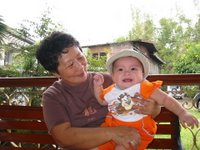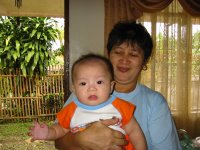- My Nana, the tita cousins , my lola ninang
- My tatay & my inay
Friday, December 30, 2005
Sunday, December 25, 2005
5 months!

5 months
Mastered Skills (most kids can do)
• Can distinguish between bold colors
• Can roll over
• Amuses himself by playing with hands and feet
Emerging Skills (half of kids can do)
• Turns toward new sounds
• Recognizes own name
Advanced Skills (a few kids can do)
• May sit momentarily without support
• Mouths objects
• Stranger anxiety may begin
Wednesday, November 30, 2005
4 months!

4 months
Mastered Skills (most kids can do)
• Holds head up steadily
• Can bear weight on legs
• Coos when you talk to him
Emerging Skills (half of kids can do)
• Can grasp a toy
• Reaches out for objects
• Can roll over
Advanced Skills (a few kids can do)
• Imitates speech sounds — baba, dada
• May cut first tooth
• May be ready for solids
Saturday, November 26, 2005
Infranrix Hexa 2nd Dose!
Special Instructions:
Paracetamol Drops 0.9ml every 4 hours for temp 37.8 and up.
Paracetamol Drops 0.9ml every 4 hours for temp 37.8 and up.
Sunday, October 30, 2005
3 months!

3 months
Mastered Skills (most kids can do)
• Laughs
• Holds head steady
• Recognizes your face and scent
Emerging Skills (half of kids can do)
• Squeals, gurgles, coos
• Recognizes your voice
• Does mini-pushups
Advanced Skills (a few kids can do)
• Turns toward loud sounds
• Can bring hands together and may bat at toys
• Can roll over
Saturday, October 15, 2005
Saturday, October 08, 2005
2 months!

2 months
Mastered Skills (most kids can do)
• Vocalizes sounds — gurgling and cooing
• Follows objects
• Holds head up for short periods
Emerging Skills (half of kids can do)
• Smiles, laughs
• Holds head at 45-degree angle
• Movements become smoother
Advanced Skills (a few kids can do)
• Holds head steady
• Bears weight on legs
• May lift head and shoulder (mini-pushup)
Saturday, September 24, 2005
Infanrix Hexa - First Dose!
Special Instruction: Paracetamol Drops 0.06ml every 4 hours for temp 37.8 and above.
Thursday, September 15, 2005
INFANRIX hexa
INFANRIX hexa is a vaccine used to prevent six diseases:
diphtheria, tetanus, pertussis(whooping cough), hepatitis B,poliomyelitis (polio) and Haemophilus influenzae type b (Hib). The vaccine works by causing the body to produce its
own protection (antibodies) against these diseases.
Diphtheria
Diphtheria mainly affects the airways and sometimes the skin. Generally the airways become inflamed (swollen) causing severe breathing difficulties and sometimes suffocation. The bacteria
also release a toxin (poison), which can cause nerve damage, heart problems, and death. The risk of serious complications and death is greater in the very young and elderly.
Tetanus (Lockjaw)
Tetanus bacteria enter the body through wounded skin. Wounds that are especially prone to infection are burns, fractures, deep wounds or wounds contaminated with soil, dust, horse manure or wood splinters. The bacteria release a toxin (poison), which can cause muscle
stiffness, painful muscle spasms, fits and death. The spasms can be strong enough to cause bone
fractures of the spine. The death rate is 10% of cases.
Pertussis (Whoopingcough)
Pertussis is a highly infectious illness. The disease affects the breathing tract causing severe spells of coughing that may interfere with normal breathing. The coughing is often accompanied by a ‘whooping’ sound. The cough may last for 1-2 months or longer. Pertussis can also cause inner ear infections, long-lasting bronchitis, pneumonia, fits, brain damage and death. The
risk of severe complications and death is greatest in infants under 6 months of age. The death rate is 0.5% for infants under 6 months of age.
Hepatitis B
Hepatitis B is caused by the hepatitis B virus. It causes the liver to be become swollen (inflamed). The virus is found in body fluids such as blood, semen, vaginal secretions, or saliva of
infected people. The virus can enter the bloodstream through:
· an infected mother passing the virus onto her baby during or shortly after birth
· sores, cuts or tiny wounds coming into contact with infected fluids (eg from a human bite, sharing razors or toothbrushes, or working with human blood or body fluids)
· injection (eg needlestick injury, or sharing needles for IV drug use)
· sexual intercourse
Some people infected with hepatitis B may not look or feel sick. But others will get symptoms, which may not be seen for 6 weeks to 6 months after infection. Sometimes people will only have mild flu like symptoms, but other people can become very ill. They may be extremely tired, and have dark urine, pale faeces, yellowish skin and/or eyes (jaundice), and other symptoms possibly requiring hospitalisation.Most adults fully recover from the disease. However, some people, particularly children, who may not have had symptoms, can remain infected. They are called hepatitis B virus carriers. Hepatitis B carriers can infect others throughout their lives.
Babies infected with hepatitis B at birth almost always become carriers. Often they do not show
symptoms, and seem healthy for many years. However, after 30, 40 or 50 years they can become sick and develop symptoms. For all chronic hepatitis B carriers there is a risk of serious
liver disease, such as cirrhosis (liver scarring) and liver cancer. There is no specific treatment for hepatitis B.
Poliomyelitis (Polio)
Polio is a viral infection that can have variable effects. Often it causes only a mild illness but in some people it causes permanent injury or death. In its severest form, polio infection causes paralysis of the muscles, including those needed for breathing and walking. Polio infection can leave a person unable to breathe without the help of an iron lung machine, unable to walk
without leg braces, or confined to a wheel chair. The limbs affected by the disease may be painfully deformed.
Haemophilus influenzae type b (Hib)
Hib most frequently causes brain inflammation (swelling), which is generally seen in infants under 18 months of age. The death rate is 5-10% of infants in this age group. In 15-30% of
surviving infants there will be some type of serious complication such as: mental retardation, cerebral palsy, deafness, epilepsy or partial blindness. Hib also causes inflammation of the
throat, which is mostly seen in children over 18 months of age. It occasionally causes death by suffocation. Less commonly, the bacteria can also infect the blood, heart, lungs, bones, joints, and tissues of the eyes and mouth.
INFANRIX hexa is usually given as a total of three doses as follows:
First dose: 2 months of age
Second dose: 4 months of age
Third dose: 6 months of age
Each dose is given on a separate visit. INFANRIX hexa should not be given at birth.
diphtheria, tetanus, pertussis(whooping cough), hepatitis B,poliomyelitis (polio) and Haemophilus influenzae type b (Hib). The vaccine works by causing the body to produce its
own protection (antibodies) against these diseases.
Diphtheria
Diphtheria mainly affects the airways and sometimes the skin. Generally the airways become inflamed (swollen) causing severe breathing difficulties and sometimes suffocation. The bacteria
also release a toxin (poison), which can cause nerve damage, heart problems, and death. The risk of serious complications and death is greater in the very young and elderly.
Tetanus (Lockjaw)
Tetanus bacteria enter the body through wounded skin. Wounds that are especially prone to infection are burns, fractures, deep wounds or wounds contaminated with soil, dust, horse manure or wood splinters. The bacteria release a toxin (poison), which can cause muscle
stiffness, painful muscle spasms, fits and death. The spasms can be strong enough to cause bone
fractures of the spine. The death rate is 10% of cases.
Pertussis (Whoopingcough)
Pertussis is a highly infectious illness. The disease affects the breathing tract causing severe spells of coughing that may interfere with normal breathing. The coughing is often accompanied by a ‘whooping’ sound. The cough may last for 1-2 months or longer. Pertussis can also cause inner ear infections, long-lasting bronchitis, pneumonia, fits, brain damage and death. The
risk of severe complications and death is greatest in infants under 6 months of age. The death rate is 0.5% for infants under 6 months of age.
Hepatitis B
Hepatitis B is caused by the hepatitis B virus. It causes the liver to be become swollen (inflamed). The virus is found in body fluids such as blood, semen, vaginal secretions, or saliva of
infected people. The virus can enter the bloodstream through:
· an infected mother passing the virus onto her baby during or shortly after birth
· sores, cuts or tiny wounds coming into contact with infected fluids (eg from a human bite, sharing razors or toothbrushes, or working with human blood or body fluids)
· injection (eg needlestick injury, or sharing needles for IV drug use)
· sexual intercourse
Some people infected with hepatitis B may not look or feel sick. But others will get symptoms, which may not be seen for 6 weeks to 6 months after infection. Sometimes people will only have mild flu like symptoms, but other people can become very ill. They may be extremely tired, and have dark urine, pale faeces, yellowish skin and/or eyes (jaundice), and other symptoms possibly requiring hospitalisation.Most adults fully recover from the disease. However, some people, particularly children, who may not have had symptoms, can remain infected. They are called hepatitis B virus carriers. Hepatitis B carriers can infect others throughout their lives.
Babies infected with hepatitis B at birth almost always become carriers. Often they do not show
symptoms, and seem healthy for many years. However, after 30, 40 or 50 years they can become sick and develop symptoms. For all chronic hepatitis B carriers there is a risk of serious
liver disease, such as cirrhosis (liver scarring) and liver cancer. There is no specific treatment for hepatitis B.
Poliomyelitis (Polio)
Polio is a viral infection that can have variable effects. Often it causes only a mild illness but in some people it causes permanent injury or death. In its severest form, polio infection causes paralysis of the muscles, including those needed for breathing and walking. Polio infection can leave a person unable to breathe without the help of an iron lung machine, unable to walk
without leg braces, or confined to a wheel chair. The limbs affected by the disease may be painfully deformed.
Haemophilus influenzae type b (Hib)
Hib most frequently causes brain inflammation (swelling), which is generally seen in infants under 18 months of age. The death rate is 5-10% of infants in this age group. In 15-30% of
surviving infants there will be some type of serious complication such as: mental retardation, cerebral palsy, deafness, epilepsy or partial blindness. Hib also causes inflammation of the
throat, which is mostly seen in children over 18 months of age. It occasionally causes death by suffocation. Less commonly, the bacteria can also infect the blood, heart, lungs, bones, joints, and tissues of the eyes and mouth.
INFANRIX hexa is usually given as a total of three doses as follows:
First dose: 2 months of age
Second dose: 4 months of age
Third dose: 6 months of age
Each dose is given on a separate visit. INFANRIX hexa should not be given at birth.
Saturday, September 10, 2005
Friday, September 02, 2005
Monday, August 29, 2005
1 Month!

1 month
Mastered Skills (most kids can do)
• Lifts head
• Responds to sound
• Stares at faces
Emerging Skills (half of kids can do)
• Follows objects
• Ooohs and ahhs
• Can see black-and-white patterns
Advanced Skills (a few kids can do)
• Smiles
• Laughs
• Holds head at 45-degree angle
Saturday, August 13, 2005
My First Vaccine!
Tuesday, August 09, 2005
Friday, August 05, 2005
What is BCG?
Bacille Calmette Guerin (BCG) is the most widely used vaccination in the world. BCG is made of a live, weakened strain of Mycobacterium bovis, (a cousin of Mycobacterium tuberculosis, the TB bacteria). It was developed in the 1930's and it remains the only vaccination available against tuberculosis today. It is used because it is effective in reducing the likelihood and severity of TB in infants and young children. That is especially important in areas of the world where TB is highly prevalent, and the chances of an infant or young child becoming exposed to an infectious case are high.
In countries with high rates of TB, BCG is often given to infants at the time of birth because it helps prevent the more serious forms of TB disease from developing in children. Unfortunately, the positive effect of BCG in protecting infants and young children from endemic areas from the lethal forms of TB does not extend to the adult years. Thus, many people develop active tuberculosis even though they received BCG, even in multiple doses, in earlier years.
In countries with high rates of TB, BCG is often given to infants at the time of birth because it helps prevent the more serious forms of TB disease from developing in children. Unfortunately, the positive effect of BCG in protecting infants and young children from endemic areas from the lethal forms of TB does not extend to the adult years. Thus, many people develop active tuberculosis even though they received BCG, even in multiple doses, in earlier years.
Thursday, July 28, 2005
Out @ Last!
Duncan Abregunda Marcos
Date : July 25, 2005
Time : 3:23am
Place : St. Luke's Medical Center
Weight : 8.1 lbs.

Subscribe to:
Posts (Atom)













